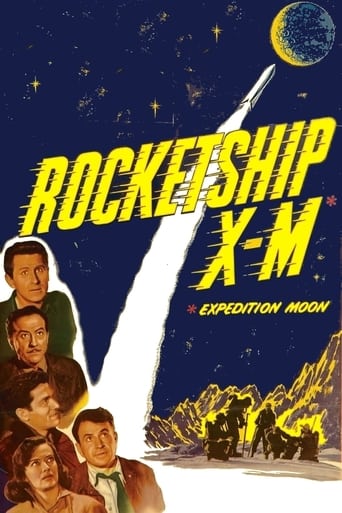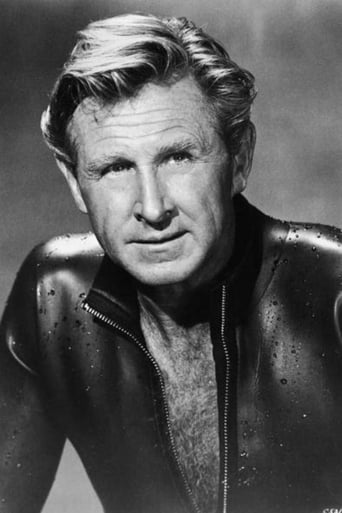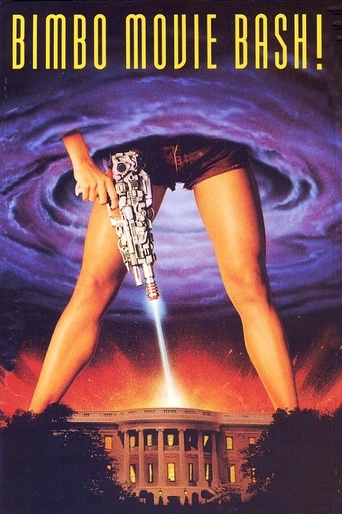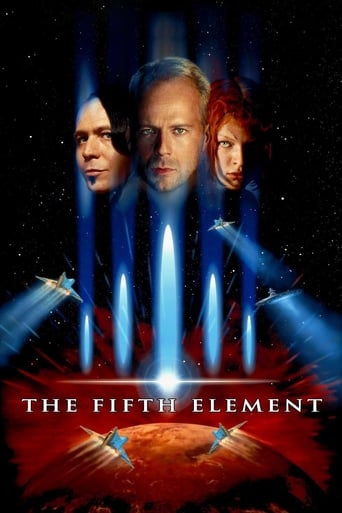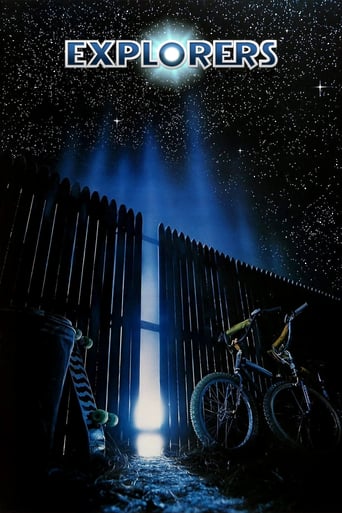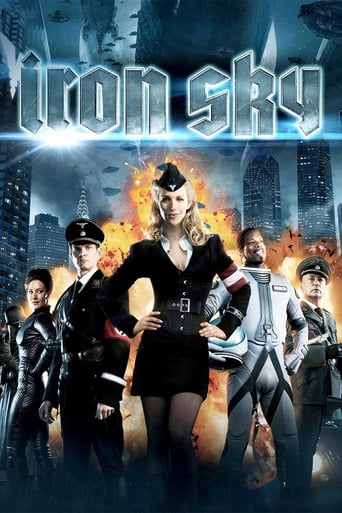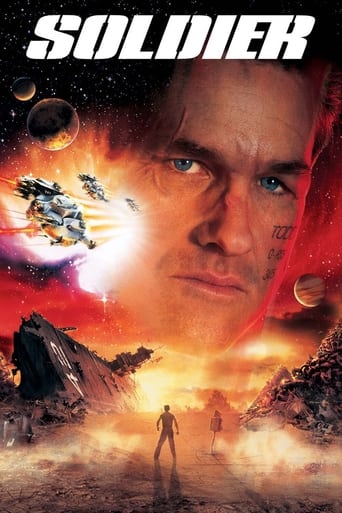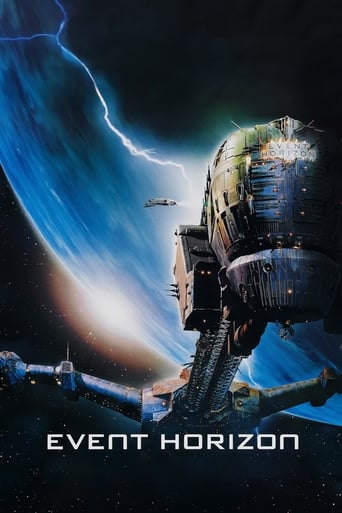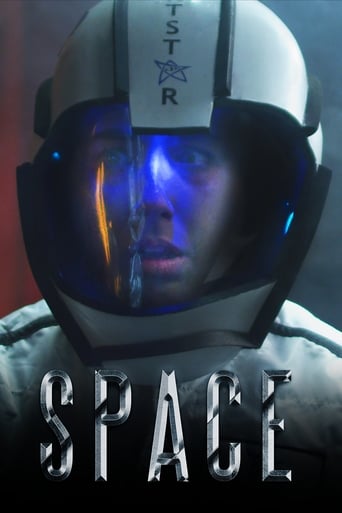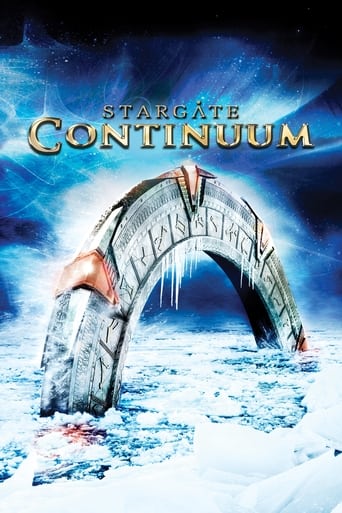Rocketship X-M (1950)
Astronauts blast off to explore the moon on Rocketship X-M or "Rocketship eXploration Moon". A spacecraft malfunction and some fuel miscalculations cause them to end up landing on Mars. On Mars, evidence of a once powerful civilization is found. The scientists determined that an atomic war destroyed most of the Martians. Those that survived reverted to a caveman like existence.
Watch Trailer
Free Trial Channels
Cast


Similar titles
Reviews
Very Cool!!!
Don't listen to the Hype. It's awful
Your blood may run cold, but you now find yourself pinioned to the story.
Mostly, the movie is committed to the value of a good time.
This is simply one of the best science fiction movies ever filmed. Excellent direction, intelligent script, and superb performances from an outstanding cast make for a masterpiece in the genre. While obviously low budget, the producers make the best of what they have to work with and they do so brilliantly. From start to finish, imaginative sequences are presented with stunning effectiveness. The location shooting in Death Valley mimics perfectly what the Martian landscape would be envisioned as in 1950. This film serves as a cautionary tale as well, with the fate of the civilization on Mars being tied to a nuclear apocalypse. The cast is uniformly excellent and the existential closing scene with the two leads is one of the most shocking and effective ever filmed. The dialog is realistic and profound and certainly unforgettable. It is a sequence, like many in this picture, which will both disturb and uplift. Rocket Ship XM is an underrated motion picture, far ahead of its time, made with passion and imagination. Even with somewhat primitive special effects, this remains on an intellectual par with some of the more thoughtful science fiction ever produced in Hollywood.
Apparently there was a 'space race' that most of us are unaware of, though in 1950 it was fast and furious. It seems that George Pal had announced a new picture (DESTINATION MOON) that would feature a moon landing and it was to be the first of many similar films made in the 1950s. However, when the makers of ROCKETSHIP X-M heard about this, they decided to rush this film into production and beat them to the punch, so to speak. However, the DESTINATION MOON people cried foul and so when ROCKETSHIP X-M was marketed, they were forced to include a proviso that it was not DESTINATION MOON. Well, I don't know how these films fared at the box office, but as far as quality goes Pal and the rest of the DESTINATION MOON people had little to worry about, as ROCKETSHIP X-M, though a decent film, wasn't nearly as well made or entertaining. It seems that although it was technically first, it certainly wasn't best. I can say this because I saw them one after another today--an interesting way to see these two milestone films.The biggest problem is that while ROCKETSHIP X-M wants to be taken as serious sci-fi, there are just too many elements in it that would soon be recognized as clichés. The most obvious was including a female crew member. This set the stage for a million and one sexist and silly remarks and while the film makers might have been trying to say something positive about women's rights, the crew member really came off as just another piece of meat. The second cliché is finding aliens on their mission, though in this case instead of either little green men or horny space babes (such as in QUEEN OF OUTER SPACE or CAT-WOMEN OF THE MOON) they are very primitive and look human. They discover cave men on Mars who apparently like to smash things--including members of the crew. In fact, because the film had so many clichés, when the film was about half-way complete, I predicted to my wife who on the crew would die in what order and I was correct! I'm not THAT smart--the film was just that predictable.In addition to the clichés, the film makers didn't do a very good job of dealing with the scientific aspects of space travel. Part of this might have been ignorance (such as having small objects on the ship float in zero gravity but not bigger ones--as if that mattered) and much of it was probably due to their desire to rush it into production (no pressure suits or other protection when walking on Mars--despite the cold temperatures and pressure difference). This made the film come off as a bit cheap, but at least I was thrilled that inside the space ship it didn't look like a big empty room. It looked a bit more like a real space ship.Overall, the film is entertaining, offers a few mild thrills and abounds with predictability as well as a message that comes off as both preachy AND premature. After only walking about for a few minutes and not even exploring the Martian cities, the scientist among the crew announces that the Martians destroyed themselves with nuclear bombs and the people living like idiot cave people was the result. How did he know this?! And why did everyone just accept this so quickly? For die-hard fans of sci-fi like myself, this is a must-see because of its historical value and it is reasonably entertaining. Others might find it tough going.
A perfectly plausible story of five astronauts who take off in a 1950s space ship, make a wrong turn, and land on Mars instead. After that, things get kind of hairy.I understand this was rushed into production while George Pal's far more lavishly budgeted "Destination Moon" was being shot, with the aim of beating the bigger and more publicized film into theaters. Well, the haste, the lesser budget, and the lesser thought, shows in "Rocket Ship X-M." Not that it's a BAD movie. I mean, it's not a Buck Rogers serial. But the difference in quality still shows.The five astronauts are Lloyd Bridges, Osa Massen, John Emery, Noah Beery, Jr., and Hugh O'Brian. All are professionals and pull off their roles without disgracing themselves, though neither can any be outstanding. How could anyone give an outstanding performance while uttering lines like, "Reduce speed level two"? Lloyd Bridges was evidently lucky enough to have his hair stylist stashed aboard somewhere because his Lenny-Briscoe haircut is never mussed. Noah Beery, Jr., is the requisite ethnic or regional type, in this case the Texan who uses double negatives and brags about the size of his state.The script, written by Kurt Neumann with additional dialog by Orville K. Hampton, at times stretches its arms out towards the literary. Osa Masson gives a colorful description of a Swiss lake under the moon, "the water like cold coffee." Somebody had to think about those lines. And Bridges manages a quote from Kipling. Okay -- Kipling -- but the quote is an apt one and someone had to have read the poem before writing the script.What the film has in the way of the odd sparkle in the dialog, it mostly lacks in science. Robert Heinlein was not the technical adviser here, as he was on "Destination Moon." When "meteorites" zip past the errant space ship, they do so with an ear-splitting WHOOSH. The distant earth looks like a map in a high-school geography text, with starkly etched tan continents and primal blue oceans and not a cloud in sight. ("Destination Moon" got that right.) The astronauts walk around in outer space as if they were in their living rooms, although some objects have a habit of arbitrarily popping up into the zero-gravity air.Osa Masson, an attractive young scientist, gets some occasional needling from the men. There are comments about her icy devotion to science and her "feminine intuition." She asks if they think she should have stayed home and baked and raised children. "Isn't that enough?", asks Bridges. It's very un-PC, naturally, but Bridges ends up suggesting that it's possible "to go too far in the other direction too," a fairly reasonable observation, not exactly anti-feminist.Osa Masson is a tough babe and can take care of herself. What was far more disturbing was Morris Ankrum as the Big Mahoff back on earth, briefing the reporters on why we need to go to the moon. His explanation? "To establish unassailable bases" so that we "can control the peace" -- just as we're controlling the peace now, I guess.
This film beat the more highly publicized Destination Moon into the theatres in 1950 and thus kicked off the tidal wave of science-fiction movies that followed. It may not have been as realistic as the latter, but it was sure as heck a lot more fun. Despite some really hokey dialog and wildly improbable developments (aim for the moon, but hit Mars!), Rocketship does what every good movie should-- it holds interest throughout. The opening scene is especially impressive with its well-stocked news conference and especially the booming countdown to blast-off. Already there's an air of thrills to come. Sure, the characters are a collection of movie stereotypes-- the jet jockey (Bridges), the likable yokel (Beery Jr.), the sexy scientist (Massen), the stern chief (Emery), and the rather unsteady engineer (O' Brien). Nonetheless, each is played with conviction, and in a real casting coup, there's the lordly Morris Ankrum back at command central.Lippert Pictures was a budget-minded company to put it kindly. Thus it's to producer-writer-director Kurt Neumann's credit that he gets so much out of the material. Note the early scene where the crew climbs up to the control compartment. The opening shot of the rocketship interior could have simply placed the crew already in that central compartment and saved some money. But it doesn't. Instead Neumann has the crew climb through the rather impressive guts of the ship, thereby creating a more believable and eye-catching transport. It's touches like this that help compensate for the occasional triteness.Speaking of touches, how well I remember audience reaction to the Martian girl when she opened her eyes to reveal two blanks. The audience let out a collective shriek. Of course, that was 1950, still a long time before today's super-sophisticated special effects. But I doubt if any of today's effects produced a stronger reaction than those two all-white lenses. (Question-- is that lipstick I see on the girl in this 1976 enhanced version?)There's also a subtle subtext in the movie's latter half. 1949 was the year the Soviets first tested an atomic bomb, thus establishing the possibility of the Cold War going nuclear. Note the pointed comments crew members make about the destructive potential of radioactivity once they discover its effects on the Martian civilization. That would appear to be writer Neumann making some timely observations on a menace then beginning to emerge. On a similar note, Ankrum's closing insistence that space exploration must proceed despite an ill-fated first effort is years ahead of its time, and likely the first such declaration in the movies or any other popular medium. Then too, it was rather gutsy to crash the survivors on their way back to Earth. That unhappy ending warned audiences of the human cost that exploration would inevitably take.Setting aside its strictly commercial aspects, the movie does a lot better than would normally be expected of a Lippert production, becoming rather prophetic in its own modest way. I think that's one reason for both the movie's cult status and general durability long after most contemporaries of the 1950's have faded away. Rocketship X-M remains a minor classic to this day.

